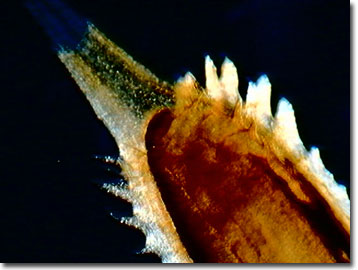Darkfield Digital Image Gallery
Dandelion Fruit
Not the typical bright colored, juicy, and sweet fruit (such as a ripe plum or peach), the fruit of the dandelion bears more resemblance to a white or grayish parachute. The dandelion fruits are attached to the seeds by long stalks, and are a critical dispersal mechanism for this weedy perennial herb that depends on wind rather than animals, water, gravity, or fruit eruptions for completing its life cycle.

A fruit, whether wet or dry, is the ripened ovary in which the seeds are borne. Other fruits that feature dry, rather than fleshy pericarps (ovary wall), include the buckwheat and sunflower. Known as achenes, these fruits are derived from a follicle with a failure of dehiscence (split open, letting seeds fall out) and reduction of the number of seeds to one. The cypsela, an achene with adherent calyx, of the dandelion (Taraxacum officinale) weed, is one of three types that include the winged achene or samara (for example, the winged fruits of elms and maples), and the utricles (bladdery achene with a loose fitting pericarp around the seed). Achenes are common in the families of Ranunculaceae (buttercups), Polygonaceae, and Asteraceae (sunflowers, including dandelions). Asters, goldenrods, milkweeds, clematis, thistles, cattails, and willows also utilize the dandelion seed dispersal strategy of producing fruits with tufts of hairs that catch the winds.
The cypsela of the perennial dandelion is classified as an anthocarp. An anthocarp is a fruit formed from the ovary and attached floral parts, which has undergone dramatic development after fertilization to aid the dissemination of the seeds. The white, feathery tufts of the dandelion pericarp fruit are known as pappi. The pappus develops from the flower and acts as a fluffy parachute that is easily dispersed by wind over long distances. Since the dandelion uses anemochory (wind-dependent dispersion), a lightweight fruit is helpful, as are the advantages imparted by an aerodynamic design, such as that of the plumed dandelion fruit. A wind of only 2 miles per hour can keep a dandelion achene aloft, therefore a strong wind or storm can transport the weed's seeds for hundreds of miles.
The flower head of a dandelion is actually a composite of small flowers known as florets. Each of the florets produces a single seed that attaches to the pappus via the beak, a thin stalk. After pollination, the dandelion flower dries out for about 10 days and then the seed-bearing parachutes expand and lift out of the dried flower head. The dried part of the flower drops off and the parachute ball opens into a full sphere. Interestingly, each of the dandelion fruits is sensitive to moisture and will close up on a rainy day, awaiting a dry, breezy day to disperse. The parachute drops off when the seed strikes an obstacle. Often dandelions can be observed growing in a crevice near a wall, because the blowing fruits hit the wall and the feathery pappi drop off, sending the dandelion seeds to the base of the obstacle where they germinate.
Contributing Authors
Cynthia D. Kelly, Thomas J. Fellers and Michael W. Davidson - National High Magnetic Field Laboratory, 1800 East Paul Dirac Dr., The Florida State University, Tallahassee, Florida, 32310.
BACK TO THE DARKFIELD IMAGE GALLERY
BACK TO THE DIGITAL IMAGE GALLERIES
Questions or comments? Send us an email.
© 1995-2025 by Michael W. Davidson and The Florida State University. All Rights Reserved. No images, graphics, software, scripts, or applets may be reproduced or used in any manner without permission from the copyright holders. Use of this website means you agree to all of the Legal Terms and Conditions set forth by the owners.
This website is maintained by our
Graphics & Web Programming Team
in collaboration with Optical Microscopy at the
National High Magnetic Field Laboratory.
Last Modification Friday, Nov 13, 2015 at 01:19 PM
Access Count Since September 17, 2002: 38497
Visit the website of our partner in introductory microscopy education:
|
|
